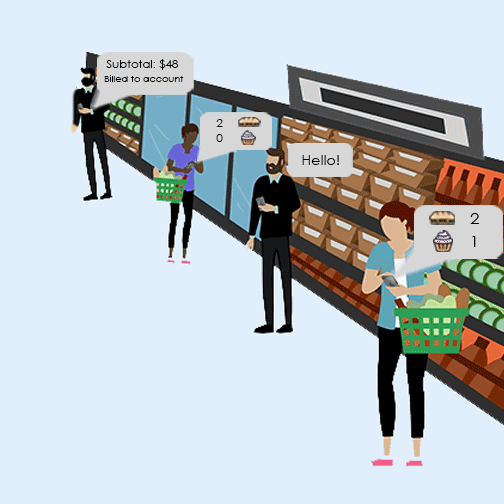A step into the digitized Amazon Go store

March 1, 2018
It’s been a busy day, but before you get home, you need to go grocery shopping for dinner; luckily, there’s an Amazon Go store right around the corner. As you enter, dozens of cameras, the genius behind it all, lay hidden in the rafters monitoring the store below as customers browse the products. Swiftly, you pick out the groceries you need and walk out within ten minutes. Once you leave the gates, the Amazon Go app bills your account with the items you purchased, stealthily picked up by the cameras.
Located in Seattle, the Amazon Go store opened to the public in January 2018 to make shopping more convenient for customers. The store itself includes items found in traditional grocery stores. The only notable difference is the checkout process, in which customers can simply enter the store using the Amazon app, pick out what they want and walk out without the hassle of a checkout line. The store streamlines the usually time-consuming process of shopping by eliminating unnecessary interactions and allowing customers to pay at their own convenience.
In order to enter the store, potential customers must download the free Amazon Go app and log in with their Amazon account. The store’s “Just Walk Out” technology automatically detects when items are taken from or placed on shelves and keeps track of them in customers’ virtual carts, which holds the items they have picked up. The Amazon Go store is heavily equipped with surveillance cameras placed everywhere around the store, in shelves and above aisles. Cameras use computer vision, allowing the system to “see” what or who is in front of them and to detect if an item has been taken off a shelf. With its extensive network of cameras, Amazon Go can track what people buy and bill them accordingly. Several human employees also work behind the store to train the algorithms and make sure that the technology is as accurate as possible. They also help restock shelves and locate products. When customers leave the store, their Amazon account is billed and they are sent an online receipt of their purchase.
“Personally, I’m fascinated at how quickly Amazon has been able to capitalize on recent advances in artificial intelligence to their own commercial applications,” said senior Bryan Chiang. “It’s always interesting to see how companies are able to leverage new scientific knowledge, in this case from the field of computer vision, to create products that benefit society.”
Amazon Go is powered by artificial intelligence technology that integrates computer vision, sensor fusion and deep learning, allowing customers to pick up items and leave without any additional effort. Artificial intelligence makes it possible for machines to learn from experience and perform human-like tasks such as visual perception, voice recognition and translations between languages.
The development and use of artificial intelligence is recent, but has already proven itself to be immensely powerful. It can help reduce error and aid humans in jobs where precision and accuracy are highly important; self-driving cars are a modern example of this technology. The use of artificial intelligence in these cars can be safer than human drivers, who are prone to making mistakes and missing details on the road, which can lead to fatal accidents. Self-driving cars can make driving more convenient and less stressful and allow passengers to be safer.
“There has even been work done on helping natural disaster relief by analyzing social media posts to find places where the most help is needed,” said senior Myra Cheng. “I was reading about how people were looking at third world countries through satellite images. With that, they can see where the most impoverished areas are and where we need to give the most aid. There are also machines analyzing global warming and environmental data, which I think that are really important applications.”
With the rise in artificial intelligence, however, have come concerns of its moral and ethical use. Renowned physicist Stephen Hawking and Tesla and SpaceX CEO Elon Musk, among dozens of other leading experts in the field of artificial intelligence, expressed negative sentiments regarding its implications in an “Open Letter on Artificial Intelligence,” despite acknowledging its potential. Artificial intelligence, after all, is intelligent: it learns and acts on a mind of its own. Scenarios reminiscent of Hollywood films like “Terminator” and “The Matrix” are probably kept safely in our imagination, but, as Hawking notes, the capabilities of artificial intelligence are simply unknown. Previous tests indicate that artificially intelligent machines could eventually surpass humans and become “superintelligent” at exceedingly fast rates, making them difficult to control. It is a new and volatile technology, and with great prosperity can also come risks that even professionals are not fully aware of yet.
Even now, kiosks and machines are becoming increasingly more prevalent in restaurants and stores, replacing jobs previously held by humans. With artificial intelligence, the capacity of jobs that can be performed by machines is increasing. It is also cost-efficient to employ the use of machines at one-time costs as opposed to hourly wages for people. Amazon Go claims that it has not replaced its need for human employees; rather, it has placed them in places of need elsewhere in the store, like the wine and beer section, to check the age of customers or simply to guide shoppers as they navigate and explore the store. Nevertheless, people who traditionally hold the jobs that are being accomplished by AI and robots are in the process of attaining, or do not have access to, higher level jobs. By removing their ability to attain these lower level jobs, they will not be able to work and make an income to support themselves.
“Some problems are inevitable as we continue to innovate,” said Chiang. “But I think there are definitely ways to mitigate its effects. For people already stuck in these positions, government programs that help them find new or related roles that can’t be easily replicated by machines is a good start. Also helping people seek higher education, whether its online or at local colleges, will probably be integral to this process.”
More threatening than just replacing human jobs, however, is the fact that artificial intelligence has already become integrated into the processes and decisions we make. They’re hidden behind the ads targeted toward you on Facebook, tailored to your tastes based on algorithms that constantly analyze your browsing and shopping habits online. Within certain companies, it’s used to screen applicants and determine optimal candidates. Our lives already revolve around the decisions that artificial intelligence make for us, whether we know it or not.
“I think recently, one of the problems is that people are becoming more reliant on machine learning in a lot of everyday applications,” said Cheng. “For example, with Amazon Go or some criminal or justice trials, they use machine learning to try and analyze that. They found that those algorithms have bias against African Americans. One really big problem with artificial intelligence is that we really need to keep in mind how to eliminate bias, how to be inclusive with everybody who is being affected by these technologies.”
Despite concerns and controversies surrounding the use of artificial intelligence, its ability to push the boundaries of our world is immeasurable. Amazon’s foray into creating the ultimate shopping experience is just an indication of how far technology like this can go. The effectiveness and usability of artificial intelligence is almost unquestionable; the only concern regarding its use is whether or not development of the technology exceeds our means to regulate it.




























































